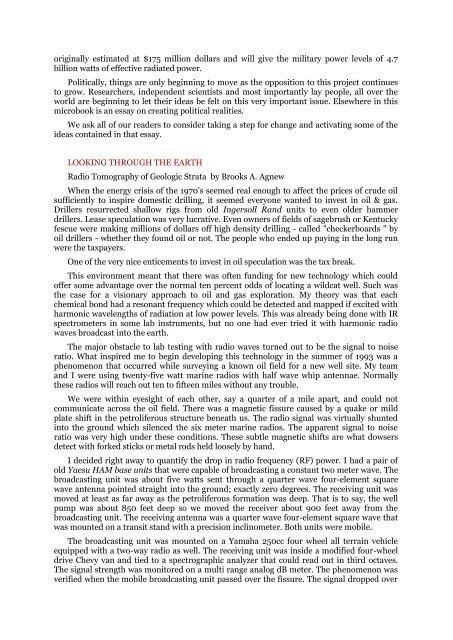ANGELS DON‘T PLAY THIS HAARP Advances in Tesla Technology
ANGELS DON‘T PLAY THIS HAARP Advances in Tesla Technology
ANGELS DON‘T PLAY THIS HAARP Advances in Tesla Technology
You also want an ePaper? Increase the reach of your titles
YUMPU automatically turns print PDFs into web optimized ePapers that Google loves.
orig<strong>in</strong>ally estimated at $175 million dollars and will give the military power levels of 4.7<br />
billion watts of effective radiated power.<br />
Politically, th<strong>in</strong>gs are only beg<strong>in</strong>n<strong>in</strong>g to move as the opposition to this project cont<strong>in</strong>ues<br />
to grow. Researchers, <strong>in</strong>dependent scientists and most importantly lay people, all over the<br />
world are beg<strong>in</strong>n<strong>in</strong>g to let their ideas be felt on this very important issue. Elsewhere <strong>in</strong> this<br />
microbook is an essay on creat<strong>in</strong>g political realities.<br />
We ask all of our readers to consider tak<strong>in</strong>g a step for change and activat<strong>in</strong>g some of the<br />
ideas conta<strong>in</strong>ed <strong>in</strong> that essay.<br />
LOOKING THROUGH THE EARTH<br />
Radio Tomography of Geologic Strata by Brooks A. Agnew<br />
When the energy crisis of the 1970's seemed real enough to affect the prices of crude oil<br />
sufficiently to <strong>in</strong>spire domestic drill<strong>in</strong>g, it seemed everyone wanted to <strong>in</strong>vest <strong>in</strong> oil & gas.<br />
Drillers resurrected shallow rigs from old Ingersoll Rand units to even older hammer<br />
drillers. Lease speculation was very lucrative. Even owners of fields of sagebrush or Kentucky<br />
fescue were mak<strong>in</strong>g millions of dollars off high density drill<strong>in</strong>g - called "checkerboards " by<br />
oil drillers - whether they found oil or not. The people who ended up pay<strong>in</strong>g <strong>in</strong> the long run<br />
were the taxpayers.<br />
One of the very nice enticements to <strong>in</strong>vest <strong>in</strong> oil speculation was the tax break.<br />
This environment meant that there was often fund<strong>in</strong>g for new technology which could<br />
offer some advantage over the normal ten percent odds of locat<strong>in</strong>g a wildcat well. Such was<br />
the case for a visionary approach to oil and gas exploration. My theory was that each<br />
chemical bond had a resonant frequency which could be detected and mapped if excited with<br />
harmonic wavelengths of radiation at low power levels. This was already be<strong>in</strong>g done with IR<br />
spectrometers <strong>in</strong> some lab <strong>in</strong>struments, but no one had ever tried it with harmonic radio<br />
waves broadcast <strong>in</strong>to the earth.<br />
The major obstacle to lab test<strong>in</strong>g with radio waves turned out to be the signal to noise<br />
ratio. What <strong>in</strong>spired me to beg<strong>in</strong> develop<strong>in</strong>g this technology <strong>in</strong> the summer of 1993 was a<br />
phenomenon that occurred while survey<strong>in</strong>g a known oil field for a new well site. My team<br />
and I were us<strong>in</strong>g twenty-five watt mar<strong>in</strong>e radios with half wave whip antennae. Normally<br />
these radios will reach out ten to fifteen miles without any trouble.<br />
We were with<strong>in</strong> eyesight of each other, say a quarter of a mile apart, and could not<br />
communicate across the oil field. There was a magnetic fissure caused by a quake or mild<br />
plate shift <strong>in</strong> the petroliferous structure beneath us. The radio signal was virtually shunted<br />
<strong>in</strong>to the ground which silenced the six meter mar<strong>in</strong>e radios. The apparent signal to noise<br />
ratio was very high under these conditions. These subtle magnetic shifts are what dowsers<br />
detect with forked sticks or metal rods held loosely by hand.<br />
I decided right away to quantify the drop <strong>in</strong> radio frequency (RF) power. I had a pair of<br />
old Yaesu HAM base units that were capable of broadcast<strong>in</strong>g a constant two meter wave. The<br />
broadcast<strong>in</strong>g unit was about five watts sent through a quarter wave four-element square<br />
wave antenna po<strong>in</strong>ted straight <strong>in</strong>to the ground; exactly zero degrees. The receiv<strong>in</strong>g unit was<br />
moved at least as far away as the petroliferous formation was deep. That is to say, the well<br />
pump was about 850 feet deep so we moved the receiver about 900 feet away from the<br />
broadcast<strong>in</strong>g unit. The receiv<strong>in</strong>g antenna was a quarter wave four-element square wave that<br />
was mounted on a transit stand with a precision <strong>in</strong>cl<strong>in</strong>ometer. Both units were mobile.<br />
The broadcast<strong>in</strong>g unit was mounted on a Yamaha 250cc four wheel all terra<strong>in</strong> vehicle<br />
equipped with a two-way radio as well. The receiv<strong>in</strong>g unit was <strong>in</strong>side a modified four-wheel<br />
drive Chevy van and tied to a spectrographic analyzer that could read out <strong>in</strong> third octaves.<br />
The signal strength was monitored on a multi range analog dB meter. The phenomenon was<br />
verified when the mobile broadcast<strong>in</strong>g unit passed over the fissure. The signal dropped over


